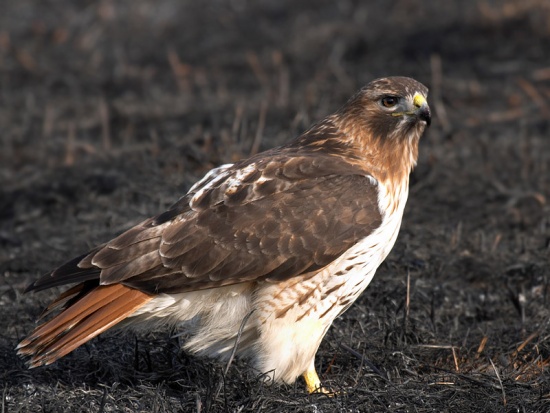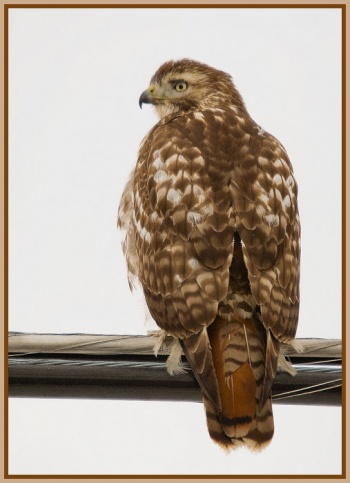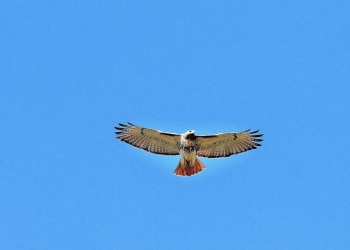- Buteo jamaicensis
Identification
Adult: Length 48cm (19in). Wingspan 125cm (49in). A large, stocky hawk with a whitish breast with dark band, usually rusty tail, and dark leading edge on wing (patagial mark -- seen during flight).
Immature: Duller, more streaked, and light brown tail with some dark barring.
This species is quite variable in colour, especially in the western U.S., where blackish individuals occur; these often retain a rusty or reddish tail. One of the most diagnostic field marks is the "cumberbund"; an area on the middle breast that is usually streaked darker than the rest of the underbody. Krider's Hawk (subspecies krideri) is a pink-tailed type from the great plains.
Similar Species
- Swainson's Hawk has darker chest, less stocky build, and narrower, more pointed wings. However, Harlan's Hawk, harlani, a very dark morph easily confused with the Swainson's Hawk.
Distribution
Year-round over most of the U.S. and Mexico; summers northward throughout the Canadian Provinces and inland Alaska.
Taxonomy
Subspecies
There are 14 subspecies[1]:
- B. j. alascensis: south-eastern Alaska and coastal British Columbia
- B. j. calurus (Western): Western North America (west of the Great Plains)
- B. j. borealis (Eastern): North America (east of the Great Plains)
- B. j. harlani (Harlan's): Interior Alaska to south-western Yukon and northern British Columbia
- B. j. kriderii (Krider's): Plains of south-central Canada to north-central US
- B. j. fuertesi (Fuertes's): Texas to northern Mexico
- B. j. hadropus: Highlands of central Mexico
- B. j. kemsiesi: Southern Mexico (Chiapas) to northern Nicaragua
- B. j. costaricensis (Costa Rican): Costa Rica and western Panama
- B. j. fumosus: Tres Marías Islands (off western Mexico)
- B. j. socorroensis: Socorro Island (Revillagigedo Islands off western Mexico)
- B. j. umbrinus: Florida
- B. j. jamaicensis: Jamaica, Hispaniola, Puerto Rico and northern Lesser Antilles
- B. j. solitudinis: Bahamas and Cuba
Two additional subspecies: suttoni, and lucasanus are not recognised by all authorities[2].
Harlan's Hawk (subspecies harlani) has in the past been considered a separate species, and proposals have been put forward to adopt that treatment again.
Habitat
The most common hawk on the North America continent, B. Jamaicensis frequents woodland edges, soars above plains, and is often seen perched on utility poles where natural perches are not available.
Behaviour
Diet
Soars or perches, looking for a wide variety of food; small to medium mammals, lizards, frogs, worms, insects, bats, and small birds.
Breeding
Conservation Status
Common and plentiful, some decline due to habitat loss, although it adapts relatively easily to new environments, even urban. Many are still shot illegally for amusement.
References
- Clements, J. F., T. S. Schulenberg, M. J. Iliff, D. Roberson, T. A. Fredericks, B. L. Sullivan, and C. L. Wood. 2016. The eBird/Clements checklist of birds of the world: v2016, with updates to August 2016. Downloaded from http://www.birds.cornell.edu/clementschecklist/download/
- Avibase
- Thread in the taxonomy forum discussing Harlan's Hawk
Recommended Citation
- BirdForum Opus contributors. (2024) Red-tailed Hawk. In: BirdForum, the forum for wild birds and birding. Retrieved 25 April 2024 from https://www.birdforum.net/opus/Red-tailed_Hawk
External Links






